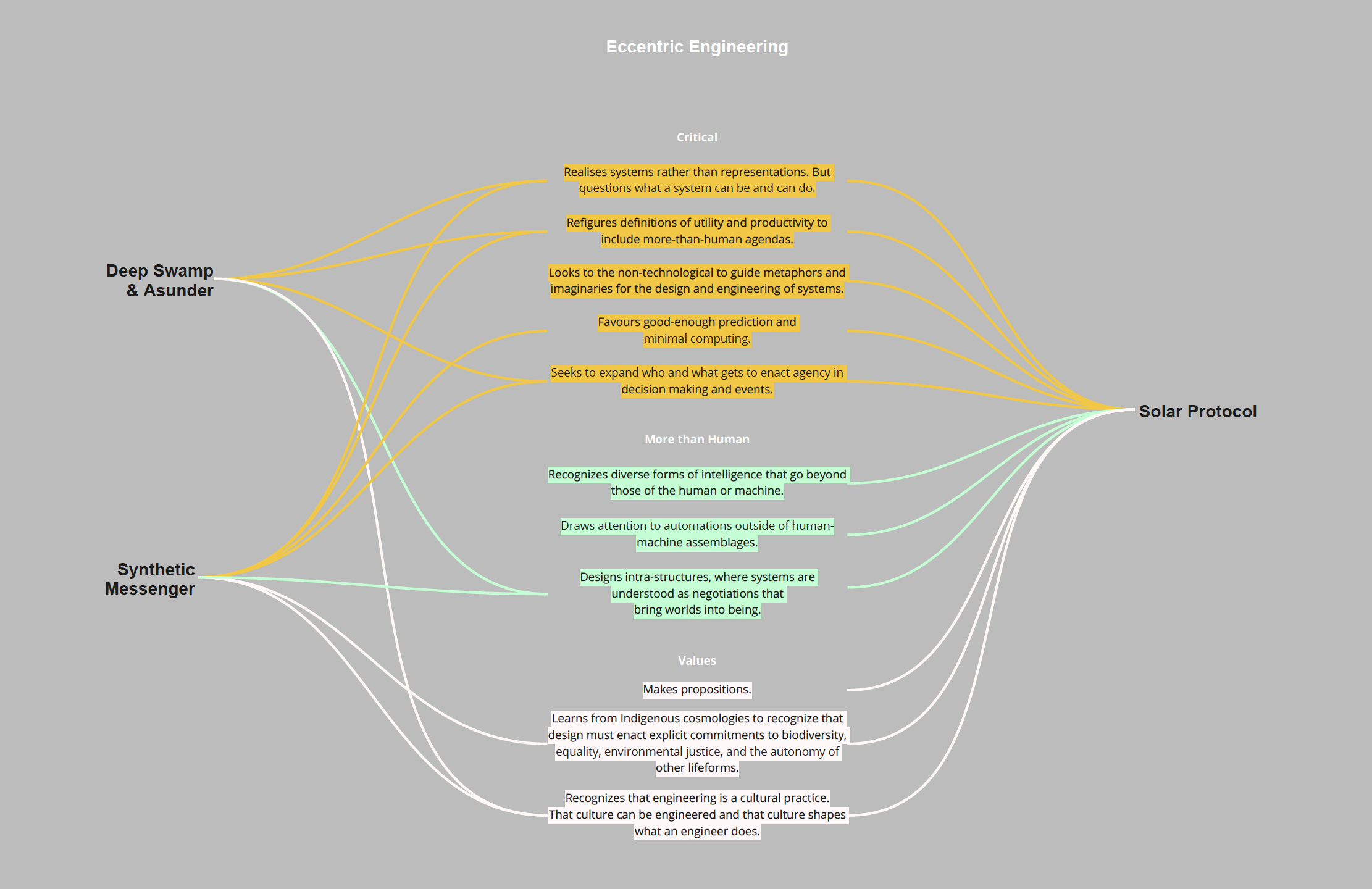This practice-led research project unfolds through the development and making of four artworks: Deep Swamp (2018),
Asunder (2019), Synthetic Messenger (2021), and Solar
Protocol (2021-2022). Each work plays out through the operation of a
technological system that attempts (or proposes, in the case of Asunder) ways
to manage or influence its ecology. Each involves the design of an automated
process that relies on a mode of perception, a technique of analysis for decision
making and then a way of proposing or confederating some sort of program of
action. Through each of these processes of perception, cognition and action,
these works explore some of the ways that data-driven computational
techniques like AI are shaping and reshaping both ecological thought and the
ways of responding to the current ecological crises.
Through the dialogue between these artworks and the exegesis, I articulate a model for an interdisciplinary art practice called eccentric engineering. Eccentric engineering draws on methods from systems art, social practice, critical engineering and ontological design to offer critiques of the technological status quo but also, importantly, generate new possibilities, imaginaries and approaches for designing systems that act in concert with their environments and which serve ecosystemic rather than exclusively human agendas.
Through the dialogue between these artworks and the exegesis, I articulate a model for an interdisciplinary art practice called eccentric engineering. Eccentric engineering draws on methods from systems art, social practice, critical engineering and ontological design to offer critiques of the technological status quo but also, importantly, generate new possibilities, imaginaries and approaches for designing systems that act in concert with their environments and which serve ecosystemic rather than exclusively human agendas.

Prompts and commitments for eccentric engineering.
Thesis Abstract
Cultivating new infrastructural and ecological imaginaries is a crucial part of addressing the climate crisis. How might we envisage ways to design and engineer our way out of the mess we are in? Where is there space to prototype new social and technological relations that depart from both the privatised techno-solutionism of Silicon Valley and the anti-technological stance of twentieth century environmentalism? This practice-led research focuses on how automated systems and AI are reshaping ecological thought, and articulates a model for practice called eccentric engineering which provides space for this much-needed thinking and experimentation. It unfolds through four artworks that each realise an automated, computational system for environmental management, and it explores how environmental knowledge is produced and applied through systems, models, media and protocols. From this dialogue between practice and theory, I show how the question of how we know our environments informs how we think we can, or should, act within them.
I also draw on non-anthropocentric theories of agency from Indigenous cosmologies of North America and Australia, new materialism, and the work of artists engaged with AI and automated systems to argue that automation is the coordination and confederation of human and non-human agencies. As such, automation is not an exclusively human intervention but equally emerges in the absence of human intent. It is a fundamental characteristic of a liveable biosphere.
From these discussions of computation, ecological thinking, and the ways artists and designers orchestrate new coalitions of agencies, this thesis concludes by defining the practice of eccentric engineering. Eccentric engineering combines methods from systems art, social practice, critical engineering and ontological design to critique the technological status quo. Importantly, it generates new possibilities, imaginaries and approaches for designing systems that act in concert with their environments and serve ecosystemic, rather than exclusively human, agendas.
I also draw on non-anthropocentric theories of agency from Indigenous cosmologies of North America and Australia, new materialism, and the work of artists engaged with AI and automated systems to argue that automation is the coordination and confederation of human and non-human agencies. As such, automation is not an exclusively human intervention but equally emerges in the absence of human intent. It is a fundamental characteristic of a liveable biosphere.
From these discussions of computation, ecological thinking, and the ways artists and designers orchestrate new coalitions of agencies, this thesis concludes by defining the practice of eccentric engineering. Eccentric engineering combines methods from systems art, social practice, critical engineering and ontological design to critique the technological status quo. Importantly, it generates new possibilities, imaginaries and approaches for designing systems that act in concert with their environments and serve ecosystemic, rather than exclusively human, agendas.